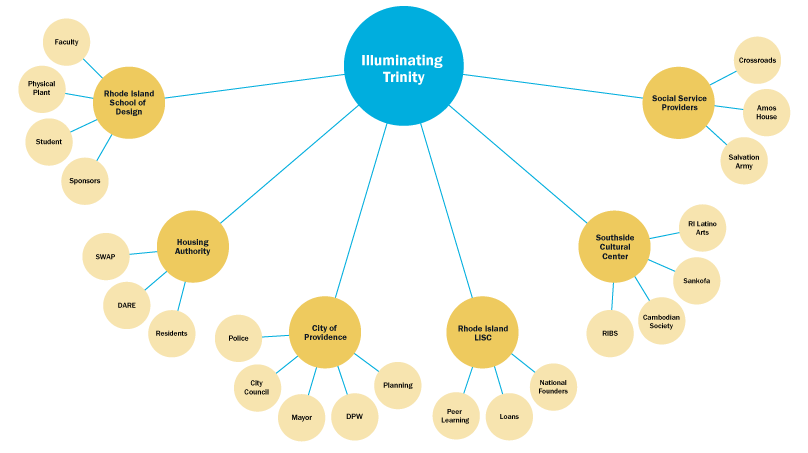An important aspect of the community engagement process is to address issues of power and influence.
Every individual involved in the placemaking process comes to the table with a unique power to impact local issues, but these systems of influence aren’t always obvious. Understanding and unpacking them early and in conversation with community members will be essential to putting your project on the path to success.
Ask yourself: How can I work with project leaders to create the conditions necessary to inspire participation and a sense of agency among our residents and community stakeholders?
"Consider: Who is in your community who might be hidden or unseen."
—Ascala Sisk, Our Town Technical Assistance Resource Team Member

Thinking about power
Another important first step in thinking about community engagement processes is to address issues of power and influence. Every person who’s involved in the engagement process comes to the table with a certain amount of power to change or influence local issues, as well as a certain amount of interest. At the beginning of a project, taking time to analyze the different dimensions of power and interest for each stakeholder can help identify issues and opportunities early. Once a project is underway, people have traditionally thought of merely “managing” these different spheres of influence. However, in creative placemaking projects, the goal is often to realign power differences and make sure that all stakeholders who are impacted by a local issue feel welcomed to the table and capable of contributing to a meaningful solution. Often, arts and culture strategies can be an ideal way to level hierarchies and bring people into new types of relationships with each other.
Navigating power imbalances between partners
Partnerships are susceptible to strenuous power dynamics related to money, experience, political clout, and more. Be sure to discuss the roles of each partner early on to give everyone a mutual understanding of what each partner sees as their responsibilities and how they fit into the project. All partners are bringing something to the table, and it is important to recognize and respect each player as a significant part of accomplishing your shared goals.
"Equity is a process as much as it is an outcome."
—Mike O'Bryan, Our Town Technical Assistance Resource Team Member
ASK FOR SUPPORT
→ Download the Worksheet
Network/relationship mapping
If mapped spatially, this same information can also begin to show patterns, cultures, and opportunities for community action.
- Who do members of the core team know?
- Who in the community has influence, makes decisions, has power?

NETWORK MAPPING
→ Download the Worksheet
Additional Resources
Curated for you by the LISC team, the resources below provide models of best practice, insights from our Resource Team, and other extras we hope will be useful to you as you navigate your creative placemaking projects.
WATCH:
Some of the Why and How for Community Engagement
You already know that residents and community stakeholders are critical to your project’s success, but can you explain it? Is it because you want residents to inform your planning? Or because residents have a role in decision-making? Thinking about the range of community engagement options is a useful tool to focus your approach to community involvement. In this session from the March 2021 Learning Lab for Our Town Grantees, Ascala Sisk will bring her considerable experience to this interactive session, where participants will explore ways to assess and focus approaches to engaging community, including the tactics and strategies that support project goals.
Designing and Building Community with the Full Human in Mind
If I ruin the crop by putting bleach in the water, would you blame the potatoes? Building on the two previous sessions on engagement, Mike O’Bryan brings his considerable skills and experience to this session from the March 2021 Learning lab for Our Town grantees where participants will explore the major dimensions of human development that shape our daily lives and the meaning we derive from our experiences/environments. He’ll review the way our brains and bodies are both consciously and unconsciously scanning for safety across all of these dimensions. Participants will reflect on this nuance in the context of designing and implementing projects—and gain understanding of the biology of stress and the science of learning and skill development through the lens of human relationships and interactions. Everyone will leave with more tools for working in and with community.